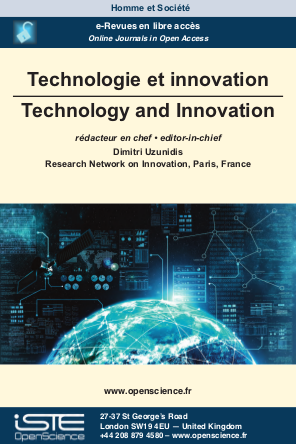

Social Sciences and Humanities > Home > Technology and Innovation > Issue
This issue of TechInn is dedicated to the topic of Blockchain, open innovation and intellectual property. It is made up of five articles. The main argument is that blockchain is a technology that can rejuvenate the field of intellectual property by extending it to new actors, in particular to innovation process contributors.
This article introduces feedback trajectories, recursive causalities which reveal the emergence of collaborative tools for agilizing processes and organizations, and for managing the asymmetries of actors on long trajectories of multi-sectoral and multi-functional innovation. The methodology of this study deals in particular with the blockchain logic of innovation processes, by mobilizing new tools for innovation acceleration strategies, such as Agile Demo-Tech Thinking. These analysis tools relate in particular to multi-actor, multi-sector approaches, the coconstruction of trust, and the participatory qualification of data and innovative projects. They involve all the stakeholders in the innovation process, which was previously a sphere of action exclusively for R&D departments. The conclusions drawn demonstrate that blockchain logic is used in conjunction with the tools of agilizing innovation processes in order for us to understand the evolution of highly collaborative innovation strategies and tools, with a focus on an empirical analysis of experiments in innovative networks in France and the United States. The evolving innovation and evaluation business models are interrelated. This scientific vision offers innovative concepts and tools and is a contribution to mesology education in its ability to integrate, in real time, continuously and together, opinions, perceptions and perceived impacts that reveal a new type of blockchain value through this new type of process, open evaluation.
Patent data is beginning to be used to map blockchain innovation systems. We use network analysis to study this system using data from the PATSTAT database. We enrich this method first by considering a classification of technologies that would be more suitable for emerging ones. Then, we expand the list of tools used for network analysis (centrality, small worlds, citations between filers). We demonstrate that inventions around blockchain – despite a type of autonomy of networks of actors that distinguish a Western dynamic from a Chinese one – experience similar technological trajectories explored in these two universes.
We discuss the potentialities of blockchains used for defense, with an emphasis on innovation in dual sectors. We argue in favor of defense guided by blockchain, with multiple levels of confidentiality, where public tenders are formulated with smart contracts. We argue that this environment would catalyze dual innovation, not only between defense and the civil sector, but also between enterprises, be they civil or military.
Endurance of evidence is particularly important in the field of intellectual property. Blockchain, with all its evolutions, could have a role to play in this field, but only if it is technically and legally regulated. In this sense, several concerns arise such as that of security, transparency, traceability and confidentiality. When it comes to all of these concerns, it is important to remember the fundamental function of trusted third parties. In France, blockchain is recognized, like all other digital proofs, as prima facie evidence in writing. In other parts of the world however, it is even more widely recognized.
We discuss the advantages of jurisdiction organized in the blockchain to achieve the harmonization of national legal systems with the European legal system. For the first time in history, blockchain offers a proper technical framework for the implementation of European legal order, as imagined by the founding fathers of Europe: a complete and harmonious model where there is no crisis among European institutions, national bodies or private economic agents.

2025
Volume 25- 10
Issue 12024
Volume 24- 9
Issue 12023
Volume 23- 8
Issue 12022
Volume 22- 7
Issue 12021
Volume 21- 6
Issue 12020
Volume 20- 5
Issue 12019
Volume 19- 4
L’innovation agile2018
Volume 18- 3
Issue 42017
Volume 17- 2
Mobility Innovations. Transport, management of flows and territories2016
Volume 16- 1
Issue 1